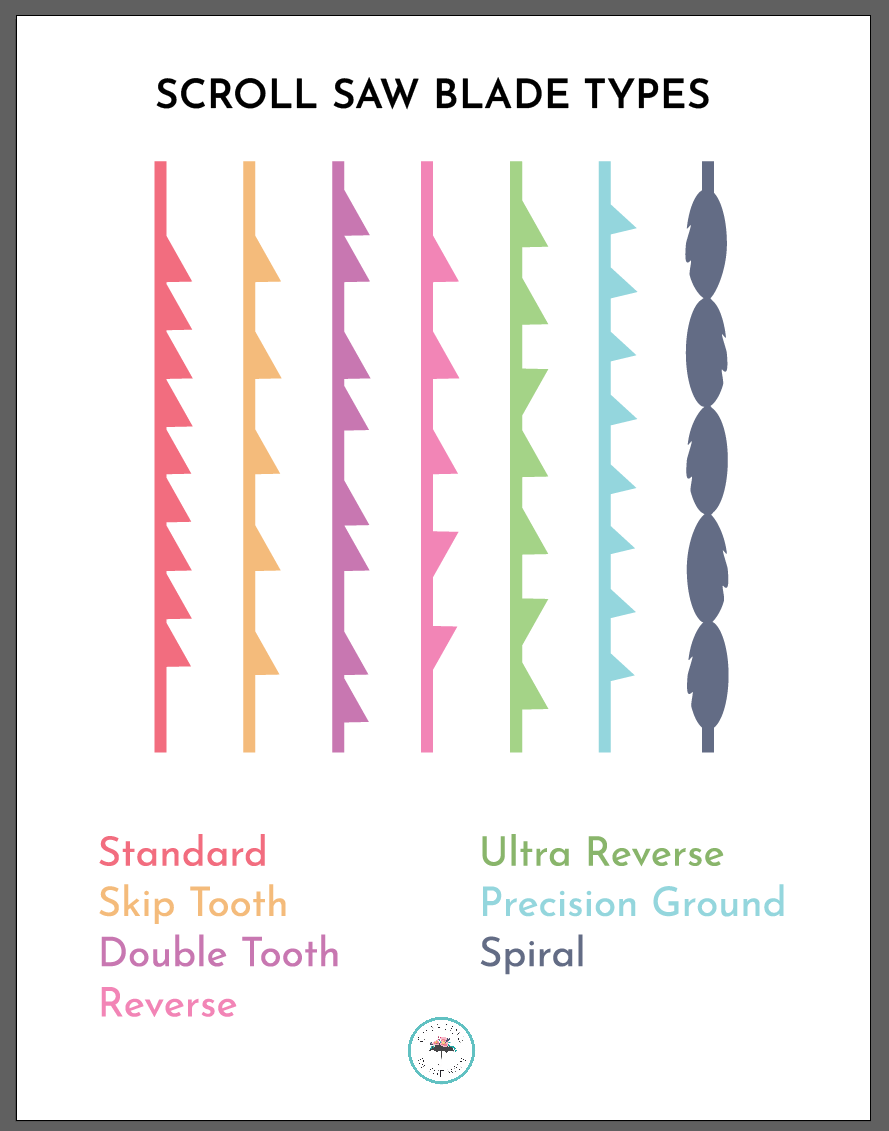Are you curious about what “tpi” means on scroll saw blades? Well, you’ve come to the right place! In this article, we’ll uncover the mystery behind this acronym and explore its significance when it comes to scroll saw blades. So, grab your magnifying glass, because we’re about to dive into the world of scroll sawing!
Picture this: you’re working on a scroll saw project, meticulously cutting intricate designs with finesse. But you notice that the blade you’re using has “tpi” stamped on it. What on earth does it mean? TPI stands for “teeth per inch.” It refers to the number of teeth present on the blade’s cutting edge in one inch of length.
Now, you might wonder, why is TPI important? The TPI value determines the blade’s cutting performance and precision. Blades with higher TPI numbers are ideal for intricate and detailed cuts in thinner materials, such as plywood or veneer. On the other hand, blades with lower TPI numbers are better suited for thicker materials like hardwood or metal, where a rougher cut is acceptable. So, understanding TPI is crucial in choosing the right blade for your specific scroll sawing needs.
So, whether you’re a beginner or a seasoned scroll saw enthusiast, understanding what TPI means on scroll saw blades will help you make informed choices. Now that we’ve unravelled this puzzle, let’s explore further and unlock the secrets of scroll sawing magic!

What Does TPI Mean on Scroll Saw Blades?
Scroll saws are a versatile tool used by woodworkers and craftsmen to create intricate designs and cuts in wood, metal, and other materials. One crucial component of a scroll saw is the blade, and understanding the terminology associated with scroll saw blades is essential for achieving the desired results. One such term is TPI, which stands for Teeth per Inch. In this article, we will delve into what TPI means on scroll saw blades, how it affects your cutting projects, and tips on choosing the right TPI for different applications.
The Importance of TPI in Scroll Saw Blades
When it comes to scroll saw blades, the TPI value refers to the number of teeth present on the blade per inch of its length. The TPI value directly affects the speed, precision, and finish of your cuts. Blades with higher TPI have more teeth, resulting in fine and intricate cuts, while blades with lower TPI have fewer teeth, allowing for faster cuts but with a rougher finish.
Choosing the right TPI for your scroll saw blade depends on various factors, including the material you’re cutting, the thickness of the material, and the level of detail required in your project. Let’s explore these factors in detail to help you make an informed decision when selecting the appropriate TPI value for your scroll saw blade.
The Material Being Cut
The type of material you’re working with plays a crucial role in determining the ideal TPI value. Different materials require different TPI ranges for optimal cutting results. For example:
- Wood: For cutting wood, a TPI range of 8 to 12 is commonly used. Blades with higher TPI in this range are ideal for intricate cuts and delicate designs, while blades with lower TPI are suitable for quick and rough cuts.
- Metal: When it comes to cutting metal, a TPI range of 18 to 32 is generally recommended. Blades with higher TPI in this range are suitable for cutting thinner metals, while blades with lower TPI can handle thicker metals.
- Plastic: Cutting plastic requires a different TPI range, typically ranging from 10 to 18. Blades with fewer teeth provide faster cuts, while blades with more teeth offer cleaner finishes.
It’s important to consider the characteristics of the material you’re working with to ensure the appropriate TPI value for your scroll saw blade.
The Thickness of the Material
The thickness of the material being cut also determines the ideal TPI value. Generally, thinner materials require blades with higher TPI for finer and more precise cuts. Thicker materials, on the other hand, can be cut efficiently using blades with lower TPI, as they remove more material with each tooth. It’s important to match the TPI value to the thickness of the material to achieve optimal cutting results.
The Level of Detail Required
The level of detail or intricacy you want to achieve in your cutting project also influences the choice of TPI value. If you’re working on a project that requires precise and intricate designs, a higher TPI blade will be more suitable. On the other hand, if you’re working on a project that requires faster and rougher cuts, a lower TPI blade will suffice. Consider the level of detail required in your project to select the appropriate TPI value.
Choosing the Right TPI for Scroll Saw Blades
TPI for Different Scroll Saw Blade Types
There are different types of scroll saw blades available, each designed for specific cutting applications. Let’s take a look at the recommended TPI ranges for some common scroll saw blade types:
- Standard/Universal Blades: These blades are suitable for a wide range of materials and cutting applications. For general cutting purposes, a TPI range of 10 to 15 is recommended.
- Skip Tooth Blades: These blades have widely spaced teeth and are ideal for cutting softwoods and thicker materials. A TPI range of 10 to 12 is commonly used.
- Spiral Blades: Spiral blades have teeth all around the blade and are excellent for cutting intricate designs and patterns. They typically have a TPI range of 20 to 60, depending on the level of detail required.
- Crown Tooth Blades: These blades have staggered teeth, making them efficient for cutting harder materials like metals. A TPI range of 9 to 18 is commonly used.
It’s crucial to follow the manufacturer’s guidelines and recommendations when selecting the appropriate TPI for a specific scroll saw blade type.
Tips for Using Scroll Saw Blades with Different TPI
Here are some additional tips to keep in mind when using scroll saw blades with different TPI values:
- Use a slower speed setting when using blades with higher TPI for better control and cleaner cuts.
- For thick materials, it may be necessary to widen the blade entry points to accommodate the blade with lower TPI.
- When cutting curves and intricate designs, blades with higher TPI provide greater precision.
- Regularly check the condition of the blade and replace it when it becomes dull to maintain optimal cutting performance.
By considering the material, thickness, and level of detail required, and selecting the appropriate TPI value for your scroll saw blades, you can achieve precise, clean, and efficient cuts for your woodworking and crafting projects.
Conclusion
Understanding what TPI means on scroll saw blades is crucial for achieving desired cutting results. The TPI value determines the speed, precision, and finish of your cuts, making it essential to choose the right TPI based on the material, thickness, and level of detail required. By considering these factors and following manufacturer recommendations, you can select the appropriate TPI value and maximize the performance of your scroll saw blades for various cutting applications. With the right TPI, you can unleash your creativity and bring your woodworking projects to life with precision and finesse.
Key Takeaways: What Does TPI Mean on Scroll Saw Blades?
- TPI stands for “Teeth Per Inch” and refers to the number of teeth on a scroll saw blade.
- A higher TPI means more teeth per inch and results in smoother, more precise cuts.
- A lower TPI, on the other hand, means fewer teeth per inch and is used for rougher, faster cuts.
- Choosing the right TPI for your scroll saw blade depends on the type of material you are cutting and the desired finish.
- It’s important to regularly check the TPI of your scroll saw blade and replace it when necessary to maintain optimal cutting performance.
Frequently Asked Questions
Interested in understanding scroll saw blades and what TPI means? Below are five common questions and their answers to help demystify this topic.
1. How does TPI affect scroll saw blades?
The acronym TPI stands for “teeth per inch.” It refers to the number of teeth on a scroll saw blade within one inch of its length. The TPI affects the cutting performance of the blade. Blades with a higher TPI have more teeth, resulting in smoother cuts on thinner materials. Conversely, blades with a lower TPI have fewer teeth and are better suited for thicker materials.
When selecting a scroll saw blade, consider the TPI in relation to the thickness of the material you plan to cut. Higher TPI blades work well for intricate cuts on thin materials like veneers, while lower TPI blades are better for thicker woods and rough cuts.
2. What TPI should I choose for scroll saw blades?
The ideal TPI for your scroll saw blade depends on the type and thickness of the material you are cutting. For thin and delicate materials, such as thin plywood or veneers, a blade with a higher TPI (18-28) is appropriate as it ensures smoother and precise cuts. When cutting thicker materials, like hardwoods or thick plywood, a lower TPI (8-15) blade is recommended to remove material more efficiently.
It’s essential to experiment and select the appropriate TPI for the specific project at hand. With experience, you’ll develop a better understanding of the TPI that works best for different materials and cuts.
3. Can I use a high TPI blade to cut thick materials?
Using a high TPI blade on thick materials is not ideal. Blades with a high TPI are designed for fine and intricate cuts on thin materials because the increased number of teeth provides smoother and more precise results. When cutting thick materials, it’s best to use a lower TPI blade that can remove material more efficiently and prevent the blade from getting stuck or broken.
Using the appropriate TPI blade ensures better cutting performance and prolongs the life of your scroll saw blades.
4. Is a higher TPI always better for scroll saw blades?
While a higher TPI is advantageous for certain cuts and materials, it may not always be better overall. A higher TPI blade is suitable for intricate and delicate cuts on thin materials. However, it can easily clog up with sawdust when cutting thicker materials, leading to slower cutting speed and potential damage to the blade.
Consider the material’s thickness and the type of cut you wish to achieve. For general-purpose cutting, a blade with a medium TPI (around 15-18) strikes a good balance between smoothness, speed, and efficiency.
5. How do I determine the TPI of a scroll saw blade?
To determine the TPI of a scroll saw blade, examine the packaging or labels provided by the blade manufacturer. It should indicate the TPI range the blade falls into. Moreover, sometimes the TPI is also engraved or printed on the blade itself.
If the TPI information is not available, you can manually count the teeth on the blade within an inch. Remember to use magnification or a visual aid if necessary to ensure accurate counting. The number you determine will be the TPI for that particular scroll saw blade.

Summary
So, what does “TPI” mean on scroll saw blades? TPI stands for “teeth per inch” and it tells you how many teeth the blade has in an inch. The more teeth, the smoother the cut.
Different TPIs are used for different materials. A lower TPI is good for cutting thicker wood, while a higher TPI is better for cutting thinner pieces. So, when choosing a scroll saw blade, consider the TPI that suits the type of material you’re working with.
